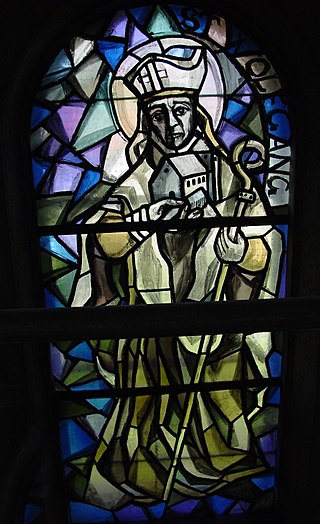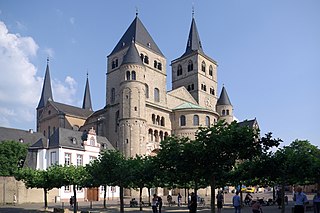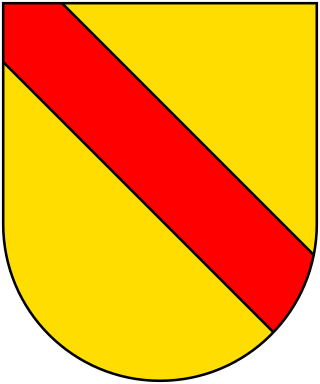
Year 1101 (MCI) was a common year starting on Tuesday of the Julian calendar. It was the 2nd year of the 1100s decade, and the 1st year of the 12th century.

Saint Wolfgang of Regensburg was bishop of Regensburg in Bavaria from Christmas 972 until his death. He is a saint in the Catholic and Eastern Orthodox churches. He is regarded as one of the three great German saints of the 10th century, the other two being Saint Ulrich of Augsburg and Saint Conrad of Constance. Towards the end of his life Wolfgang withdrew as a hermit to a solitary spot, in the Salzkammergut region of Upper Austria. Soon after Wolfgang's death many churches chose him as their patron saint, and various towns were named after him.

Anno II was Archbishop of Cologne from 1056 until his death. From 1063 to 1065 he acted as regent of the Holy Roman Empire for the minor Emperor Henry IV. Anno is venerated as a saint of the Catholic Church.

Willibrord Benzler OSB was the Roman Catholic Bishop of Metz from 1901 to 1919.

Prüm Abbey is a former Benedictine abbey in Prüm, now in the diocese of Trier (Germany), founded by the Frankish widow Bertrada the elder and her son Charibert, Count of Laon, in 721. The first abbot was Angloardus.

Maria Laach Abbey is a Benedictine abbey situated on the southwestern shore of the Laacher See, near Andernach, in the Eifel region of the Rhineland-Palatinate in Germany. It is a member of the Beuronese Congregation within the Benedictine Confederation. The abbey was built in the 11th-12th centuries and was originally known as "Abtei Laach" until 1862 when the Jesuits added the name "Maria".
Henry II "the Rich" of Nassau, German: Heinrich II. "der Reiche" von Nassau was Count of Nassau. He distinguished himself in particular by his chivalrous and devout spirit. He was charitable and made great donations to the church, so that the monasteries and prayer houses in the area of present-day Nassau experienced the most significant bloom in his time. The greatest favour was the Teutonic Order to enjoy, to which he donated especially for the renunciation of his brother's, upon his entry into the order. Henry participated in the Sixth Crusade. He was the builder of the castles Sonnenberg, Ginsburg and Dillenburg.

Affligem Abbey is a Benedictine abbey in the municipality of Affligem, Flemish Brabant, Belgium, 19 km (12 mi) to the north-west of Brussels. Dedicated in 1086, it was the most important monastery in the Duchy of Brabant and therefore often called Primaria Brabantiae.
Sigfried was Count in the Ardennes, and is known in European historiography as founder and first ruler of the Castle of Luxembourg in 963 AD, and ancestor and predecessor of the future counts and dukes of Luxembourg. He was also an advocate of the abbeys of St. Maximin in Trier and Saint Willibrord in Echternach.
Henry I was the count of Limburg and Arlon from 1082 to his death and duke of Lower Lorraine between 1101 and 1106. His mother was Jutta, daughter of Frederick, Duke of Lower Lorraine, and his father is uncertain, but possibly named Count Udon.

The Electorate of Trier was an ecclesiastical principality of the Holy Roman Empire that existed from the end of the 9th to the early 19th century. It was the temporal possession of the prince-archbishop of Trier who was, ex officio, a prince-elector of the empire. The other ecclesiastical electors were the electors of Cologne and Mainz.

Hillin of Falmagne (German: Hillin von Fallemanien, also spelled Falemagne, Fallemanien, Fallenmaigne, etc.) (c. 1100 – 23 October 1169), was the Archbishop of Trier from 1152. He was an imperialist and a partisan of Frederick Barbarossa in the Investiture Controversy of the twelfth century.

Trier in Rhineland-Palatinate, whose history dates to the Roman Empire, is the oldest city in Germany. Traditionally it was known in English by its French name of Treves.
Henry I was the Archbishop of Trier from 956 until his death.

Seck is an Ortsgemeinde – a community belonging to a Verbandsgemeinde – in the Westerwaldkreis in Rhineland-Palatinate, Germany.

The Diocese of Trier, in English historically also known as Treves from French Trèves, is a Latin Church ecclesiastical territory or diocese of the Catholic church in Germany. When it was the archbishopric and Electorate of Trier, it was one of the most important states of the Holy Roman Empire, both as an ecclesiastical principality and as a diocese of the church. Unlike the other Rhenish dioceses—including Mainz and Cologne–Trier was the former Roman provincial capital of Augusta Treverorum. Given its status, Trier has continuously been an episcopal see since Roman times and is one of the oldest dioceses in all of Germany. The diocese was elevated to an archdiocese in the time of Charlemagne and was the metropolitan for the dioceses of Metz, Toul, and Verdun. After the victory of Napoleon Bonaparte of France, the archdiocese was lowered to a diocese and is now a suffragan in the ecclesiastical province of the Archdiocese of Cologne. The diocesan cathedral is the Cathedral of Saint Peter. The Cathedral Chapter retains the right to elect the bishop, rather than selection by papal appointment.

John II of Baden was a titular Margrave of Baden and was Archbishop and Elector of Trier as John II of Baden from 1456 until his death in 1503.

The elector of Trier was one of the prince-electors of the Holy Roman Empire and, in his capacity as archbishop, administered the archdiocese of Trier. The territories of the electorate and the archdiocese were not, however, equivalent.
John I was Archbishop of Trier from 1190 to 1212 and the first also to bear the title of Elector.

Arnold II of Isenburg was Archbishop of Trier from 1242 to his death. A long-time member of the cathedral chapter in Trier, he held several provostships before being elected as archbishop, succeeding his uncle Theoderich von Wied. The election was controversial, and king Conrad IV of Germany granted the regalia to Rudolf de Ponte, the opposing candidate, instead. Arnold was confirmed as archbishop by Pope Innocent IV and consecrated in 1245.













